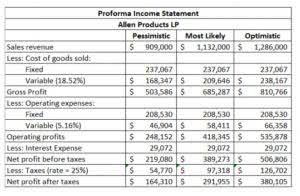
Accountants use the formula to create financial statements, and each transaction must keep the formula in balance. This bookkeeping concept helps accountants post accurate journal entries, so keep it in mind as you learn how to calculate retained earnings. If you use it correctly, an income statement will reveal the total net income of your business by calculating the difference between your assets and liabilities. This document is essential as you learn how to calculate retained earnings and other equities. To find retained earnings, you’ll need to use a formula to calculate the balance in the retained earnings account at the end of an accounting period. Also, keep in mind that unearned revenue the equation you use to get shareholders’ equity is the same you use to get your working capital.
Try QuickBooks Accounting Software for Small Businesses Free for 30 Days
Retained earnings, on the other hand, specifically refer to the portion of a company’s profits that remain within the business instead of being distributed to shareholders as dividends. It’s important to note that retained earnings are cumulative, meaning the ending retained earnings balance for one accounting period becomes the beginning retained earnings balance for the next period. It is a key indicator of a company’s ability to generate sales and it’s reported before deducting any expenses. Generally speaking, a company with a negative retained earnings balance would signal weakness because it indicates that the company has experienced losses in one or more previous years. However, it is more difficult to interpret a company with high retained earnings.
- If the company had not retained this money and instead taken an interest-bearing loan, the value generated would have been less due to the outgoing interest payment.
- Profits generally refer to the money a company earns after subtracting all costs and expenses from its total revenues.
- Retained earnings are affected by an increase or decrease in the net income and amount of dividends paid to the stockholders.
- Businesses take on expenses to generate more revenue, and net income is the difference between revenue (inflow) and expenses (outflow).
- As such, understanding this concept is essential for investors, stakeholders, and financial professionals who seek to interpret a company’s fiscal health and make informed decisions based on its financial statements.
- GAAP specifically prohibits this practice and requires that any appropriations of RE appear as part of stockholders’ equity.
How to Find Retained Earnings on Balance Sheet
Accounts with balances that are the opposite of the normal balance are called contra accounts; hence contra revenue accounts will have debit balances. Revenues and gains are recorded in accounts such as Sales, Service Revenues, Interest Revenues (or Interest Income), and Gain on Sale of Assets. These accounts normally have credit balances that are increased with a credit entry. We can find the retained earnings (shown as reinvested earnings) on the equity section of the company’s balance sheet. We can cross-check each of the formula figures used in the retained earnings calculation with the other financial statements.

What is the approximate value of your cash savings and other investments?
Both management and stockholders would also want to utilize surplus net income towards retained earnings normal balance the payment of high-interest debt over dividend payout. Every time your business makes a net profit, the retained earnings of your business increase, and a net loss leads to a decrease in the retained earnings of your business. If the retained earnings balance is gradually accumulating in size, this demonstrates a track record of profitability (and a more optimistic outlook). This means that Elena currently has $97,000 in retained earnings, a fair amount to reinvest in her business, and a good sign of future growth to her potential investors. Yes, retained earnings carry over to the next year if they have not been used up by the company from paying down debt or investing back in the company.

If a potential investor is looking at your books, they’re most likely interested in your retained earnings. Shareholders equity—also stockholders’ equity—is important if you are selling your business, or planning to bring on new investors. In that case, they’ll look at your stockholders’ equity in order to measure your company’s worth.
The steps to calculate retained earnings on the balance sheet for the current period are as follows. Retained Earnings on the balance sheet measures the accumulated profits kept by a company to date since inception, rather than issued as dividends. Retained earnings for a single period can reveal trends in the company’s reinvestment, but they don’t tell you how those funds are used, or what the return on investment is. Looking at retained earnings can be useful, but they’re more valuable when observed over a longer period of time.
- It’s safe to say that understanding the retained earnings equation and how to calculate it is essential for any business.
- To calculate Retained Earnings, the beginning Retained Earnings balance is added to the net income or loss and then dividend payouts are subtracted.
- The reconciliation of retained earnings is typically presented in the statement of retained earnings or the statement of shareholders’ equity.
- Calculating retained earnings after a stock dividend involves a few extra steps to figure out the actual amount of dividends you’ll be distributing.
- If your business currently pays shareholder dividends, you’ll need to subtract the total paid from your previous retained earnings balance.
- Other examples include (1) the allowance for doubtful accounts, (2) discount on bonds payable, (3) sales returns and allowances, and (4) sales discounts.
First, you have to figure out the fair market value (FMV) of the shares you’re distributing. Companies will also usually issue a percentage of all their stock as a dividend (i.e. a 5% stock dividend means you’re giving away 5% of the company’s equity). Sometimes when a company wants to reward its shareholders with a dividend without giving away any cash, it issues what’s called a stock dividend.
- A company’s equity reflects the value of the business, and the retained earnings balance is an important account within equity.
- Generally speaking, the par value of common stock is minimal and has no economic significance.
- As an important concept in accounting, the word “retained” captures the fact that because those earnings were not paid out to shareholders as dividends, they were instead retained by the company.
- We can cross-check each of the formula figures used in the retained earnings calculation with the other financial statements.
- This analysis can reveal insights into a company’s operational efficiency, profitability, and the effectiveness of its reinvestment strategies.
They are a type of equity—the difference between a company’s assets minus its liabilities. Businesses can choose to accumulate earnings for use in the business or pay a portion of earnings as a dividend. For instance, if your business has $20,000 left over after covering all its financial responsibilities—including operating expenses like employee salaries—you would report that money as retained earnings. Calculating retained earnings after a stock dividend involves a few extra steps to figure out the actual amount of dividends you’ll be distributing. Your bookkeeper or accountant may also be able to create monthly retained earnings statements for you.

Losses to the Company

You should report retained earnings as part of shareholders’ equity on the balance sheet. Now your business is taking off and you’re starting to make a healthy profit which means it’s time to pay dividends. On the other hand, though stock dividends do not lead to a cash outflow, the stock payment transfers part of the retained earnings to common stock. For instance, if a company pays one share as a dividend for each share held by the investors, the price per share will reduce to half because the number of shares will essentially double.
